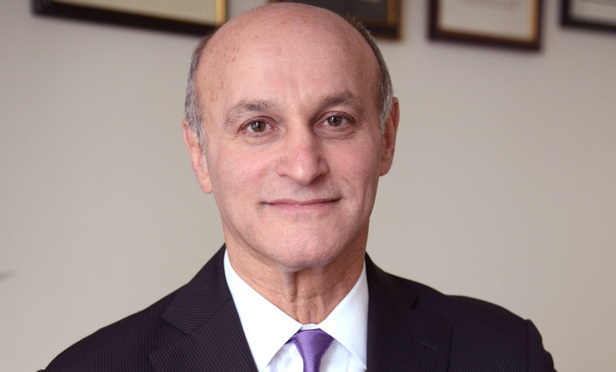The Costs Savings of Trial Court Consolidation
Lawrence K. Marks, Chief Administrative Judge of the New York State Unified Court System, examines how Chief Judge DiFiore's plan to streamline the state's court system will allow for a far more equitable allocation of resources and caseloads among the trial courts, enabling the more efficient and expeditious processing and adjudication of cases.
January 24, 2020 at 01:14 PM
6 minute read
 Chief Administrative Judge Lawrence Marks.
Chief Administrative Judge Lawrence Marks.
New York has the nation's most complex court structure, with 11 separate trial courts. This unwieldy structure makes effective administration of justice far more difficult and meaningful access to justice far less attainable for litigants in our state's courts. The Unified Court System remains committed under the Excellence Initiative to doing all it can to continue achieving efficiencies and upgrading the quality of justice we deliver. It is abundantly clear, however, that the current court structure frustrates those goals, does not serve the public well and, critically important, increases the costs of litigation in the state courts.
These problems have been evident for years, fueling multiple efforts over the past half century to restructure and simplify New York's trial court system. Chief Judge Janet DiFiore's plan will create a streamlined, transparent, and more navigable structure, replacing an antiquated, byzantine system with a modern design far better able to meet the needs and demands of 21st century litigation. It will overhaul and truncate our existing system of 11 separate and distinct trial courts, each with its own culture, practices, and jurisdictional barriers. This will allow for a far more equitable allocation of resources and caseloads among the trial courts, enabling the more efficient and expeditious processing and adjudication of cases.
Without question, this will result in substantial cost savings for litigants. The Office of Court Administration recently published a report analyzing those savings. See New York State Unified Court System, "The Probable Impact of Court Consolidation" (November 2019). This report builds upon and updates previous studies measuring the cost savings of prior trial court consolidation proposals.
Perhaps the most comprehensive of the prior studies—the 2007 "Dunne Commission" study—undertook an original analysis of the costs of the prevailing trial court structure and the savings that could be achieved if that structure were revised in accordance with a court consolidation plan closely resembling Chief Judge DiFiore's current proposal. See The Special Commission on the Future of the New York State Courts, Appendix ii, "The Financial Cost of Our Current Structure: An Economic Analysis" (February 2007). (The Special Commission was chaired by New York City attorney Carey Dunne.) The study evaluated savings that would arise from: (1) earlier resolution of cases involving multiple court appearances due to the more efficient allocation of resources and caseloads under consolidation, and (2) unified adjudication in one court before one judge of legal matters involving individual families (e.g., divorce, child custody and visitation, and domestic violence). It concluded that earlier resolution of cases would yield a 10% reduction in the number of court appearances (a fairly modest assumption), leading to 468,000 court appearances that would be avoided annually. The report determined this would save litigants $314 million annually in reduced attorney fees, fewer lost work days, lower child care expenses, and lower transportation costs.
The Dunne Commission study further concluded that unified treatment of legal matters involving individual families would lead to 408,000 annual court appearances that would be avoided, saving litigants an additional $129 million annually. Combining these amounts, the Dunne Commission concluded that, based on these efficiencies alone, trial court consolidation would save litigants $443 million in costs each year.
What the Dunne Commission found was truly eye-opening. Until the Commission's efforts, concerns about the fiscal consequences of court consolidation had largely been limited to estimates of its impact on the Judiciary's budget. No serious attempt had been undertaken to anticipate another critically important fiscal consequence—just how much a consolidation could save the public in litigation costs. That such savings could approach one-half billion dollars annually is cause for policymakers to examine the merits of consolidation in a new light.
Applying and updating the Dunne Commission analysis, the Office of Court Administration released its own cost savings analysis this past November. As noted, the Dunne Commission findings were derived from an evaluation of anticipated earlier resolution of cases due to more efficient allocation of resources and caseloads, and unified adjudication of family-related legal matters. The OCA study, applying the Dunne Commission assumptions, determined that the more efficient allocation of resources and caseloads resulting from trial court consolidation would lead to 369,200 fewer court appearances annually. This is a lesser number than the 2007 estimate because of fewer annual case filings today compared to 2007. Applying the Dunne Commission assumptions once again, the OCA study further determined that unified adjudication of family-related legal matters would lead to 204,000 fewer annual court appearances. This is also a lower number than the 2007 estimate due to the establishment in the years since the Dunne Commission report of Integrated Domestic Violence Courts, which allow for adjudication of many (although not all) of these individual family-related matters before a single judge, as well as lower annual case filings compared to the 2007 period. The OCA report did not seek to quantify the monetary value of these combined 573,200 fewer annual court appearances. (In addition to finding substantial savings to litigants, the Dunne Commission report also found savings to the Judiciary budget resulting from reduced staffing needs arising from efficiencies in processing cases. The OCA report concluded otherwise—in fact, estimating a $13.1 million increase in the Judiciary budget due to consolidation. As the OCA report explains, since issuance of the Dunne Commission report, and following the state's 2011 budget crisis, the court system today employs some 1,600 fewer staff. As a result, the court system is now ill-equipped to absorb further staff reductions.)
Clearly, the many benefits of consolidating and simplifying New York's trial courts include very substantial cost savings for litigants, savings in the hundreds of millions of dollars annually. These savings include lower attorney fees, fewer lost work days, reduced child care expenses, and lower transportation costs, among others. When added to the innumerable other benefits of trial court consolidation, the case for this critically needed improvement is overwhelming. After a half century of failed efforts, it could not be more apparent that the time for this major reform of our justice system is now. The entire legal community in this state needs to rally behind this common-sense reform. Let's not miss this opportunity for excellence in serving New Yorkers.
This content has been archived. It is available through our partners, LexisNexis® and Bloomberg Law.
To view this content, please continue to their sites.
Not a Lexis Subscriber?
Subscribe Now
Not a Bloomberg Law Subscriber?
Subscribe Now
NOT FOR REPRINT
© 2025 ALM Global, LLC, All Rights Reserved. Request academic re-use from www.copyright.com. All other uses, submit a request to [email protected]. For more information visit Asset & Logo Licensing.
You Might Like
View All


Trending Stories
- 1Thursday Newspaper
- 2Public Notices/Calendars
- 3Judicial Ethics Opinion 24-117
- 4Rejuvenation of a Sharp Employer Non-Compete Tool: Delaware Supreme Court Reinvigorates the Employee Choice Doctrine
- 5Mastering Litigation in New York’s Commercial Division Part V, Leave It to the Experts: Expert Discovery in the New York Commercial Division
Who Got The Work
J. Brugh Lower of Gibbons has entered an appearance for industrial equipment supplier Devco Corporation in a pending trademark infringement lawsuit. The suit, accusing the defendant of selling knock-off Graco products, was filed Dec. 18 in New Jersey District Court by Rivkin Radler on behalf of Graco Inc. and Graco Minnesota. The case, assigned to U.S. District Judge Zahid N. Quraishi, is 3:24-cv-11294, Graco Inc. et al v. Devco Corporation.
Who Got The Work
Rebecca Maller-Stein and Kent A. Yalowitz of Arnold & Porter Kaye Scholer have entered their appearances for Hanaco Venture Capital and its executives, Lior Prosor and David Frankel, in a pending securities lawsuit. The action, filed on Dec. 24 in New York Southern District Court by Zell, Aron & Co. on behalf of Goldeneye Advisors, accuses the defendants of negligently and fraudulently managing the plaintiff's $1 million investment. The case, assigned to U.S. District Judge Vernon S. Broderick, is 1:24-cv-09918, Goldeneye Advisors, LLC v. Hanaco Venture Capital, Ltd. et al.
Who Got The Work
Attorneys from A&O Shearman has stepped in as defense counsel for Toronto-Dominion Bank and other defendants in a pending securities class action. The suit, filed Dec. 11 in New York Southern District Court by Bleichmar Fonti & Auld, accuses the defendants of concealing the bank's 'pervasive' deficiencies in regards to its compliance with the Bank Secrecy Act and the quality of its anti-money laundering controls. The case, assigned to U.S. District Judge Arun Subramanian, is 1:24-cv-09445, Gonzalez v. The Toronto-Dominion Bank et al.
Who Got The Work
Crown Castle International, a Pennsylvania company providing shared communications infrastructure, has turned to Luke D. Wolf of Gordon Rees Scully Mansukhani to fend off a pending breach-of-contract lawsuit. The court action, filed Nov. 25 in Michigan Eastern District Court by Hooper Hathaway PC on behalf of The Town Residences LLC, accuses Crown Castle of failing to transfer approximately $30,000 in utility payments from T-Mobile in breach of a roof-top lease and assignment agreement. The case, assigned to U.S. District Judge Susan K. Declercq, is 2:24-cv-13131, The Town Residences LLC v. T-Mobile US, Inc. et al.
Who Got The Work
Wilfred P. Coronato and Daniel M. Schwartz of McCarter & English have stepped in as defense counsel to Electrolux Home Products Inc. in a pending product liability lawsuit. The court action, filed Nov. 26 in New York Eastern District Court by Poulos Lopiccolo PC and Nagel Rice LLP on behalf of David Stern, alleges that the defendant's refrigerators’ drawers and shelving repeatedly break and fall apart within months after purchase. The case, assigned to U.S. District Judge Joan M. Azrack, is 2:24-cv-08204, Stern v. Electrolux Home Products, Inc.
Featured Firms
Law Offices of Gary Martin Hays & Associates, P.C.
(470) 294-1674
Law Offices of Mark E. Salomone
(857) 444-6468
Smith & Hassler
(713) 739-1250







